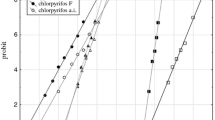Abstract
Permethrin, deltamethrin, fenvalerate and cypermethrin were evaluated for their termiticidal efficacy in a graveyard test. Semul wood, Salmalia malabaricum veneers (size 15.00 × 6.00 × 0.06 cm) were impregnated with concentrations of 0.25, 0.50 and 0.75% aqueous solution of these chemicals. Fenvalerate provided 100% protection for 44 months at all three concentrations. Cypermethrin provided 100% protection at 0.50 and 0.75% concentrations, while permethrin and deltamethrin provided 100% protection at 0.75% concentration for 7 and 10 months, respectively.
Résumé
Le perméthrine, le deltaméthrine, le fenvalerate, et le cyperméthrine ont été évalués pour leur efficacité termiticide pour tester le bois de coffrage. Des placages du bois de semul, Salmalia malabaricum (dimensions 15,00 × 6,00 × 0,06 cm) ont été imprégnés de solutions aqueuses de ces produits chimiques aux concentrations de 0,25, 0,50 et 0,75%. Le fenvalerate a donné une protection de 100% pendant 44 mois pour toutes les concentrations. Le cyperméthrine a donné 100% de protection à 0,50 et 0,75%; le perméthrine et le deltaméthrine ont donné une protection de 100% à la concentration de 0,75% pour 7 et 10 mois respectivement.
Similar content being viewed by others
References
Ali Ausat, Cheema P. S., Koshi T., Perti S. L. and Ranganathan S. K. (1960) Natural resistance of different species of timbers to termite attack. In Proc. Symp. on Termites in the Humid Tropics. UNESCO and Zoological Survey of India, 199 pp.
Anonymous (1992) The Gazette of India (Extraodinary) No. 124, February 1992, 177, 1–3.
Hirai Y. and Katsumaro T. (1991) Levels of chlordane, oxychlordane and nonachlor in human adipose tissues. Bull. Environ. Contam. Toxicol. 47, 173–176.
International Organisation for Standardisation (ISO) (1977) No. 3998. Textiles-determination of resistance to certain insect pests. Ref. No. ISO 3999-1977 (E).
Kamble S. T., Ogg C. L., Gold R. E. and Vance A. D. (1992) Exposure of applicators and residents to chlordane and heptachlor when used for subterranean termite control. Arch. Environ. Contam. Toxicol. 22, 253–259.
Kenneth G. J., Yates J. R., Minoru T. and Yamamoto R. T. (1993) Persistence of organochlorine insecticides for Formosan subterranean termite (Isoptera: Rhinotermitidae) control in Hawaii. J. Econ. Entomol. 86, 761–766.
Leidy R. B., Wright C. G. and Dupree H. E. Jr. (1991) Applicator exposure to airborne concentration of termiticide formulation of chlorpyrifos. Bull. Environ. Contam. Toxicol. 47, 177–183.
Litchfield M. H. (1985) Toxicity to mammals. In The Pyrethroid Insecticides (Edited by Leahey J. P.), p. 99. Taylor and Francis, London.
Mauldin J., Jones S. and Beal R. (1987) Viewing termiticides. Pest Control 55, 46–48, 53, 56, 57 and 59.
Perti S. L., Cheema P. S., Dixit R. S., Srivastava A. S. and Ranganathan S. K. (1963) Development of standard test method for evaluation of insect proofness of woollen textiles. Defence Sci. J. 13, 138.
Rao K. M. and Mohan M. S. (1969) Termite-proofness of flexible packaging materials for foodstuffs used in defence services. Proceedings of Symposium on Stores Preservation, pp. 27–30.
Savage P. E. (1988) Termiticide use and indoor air quality in the United States. Rev. Environ. Contam. Toxicol. 110, 117–130.
Sharma R. N. (1987) Some new frontiers in the concept and practice of insect management. In Proceedings of the Symposium on Integrated Pest Control Progress and Perceptions. Trivandrum, pp. 27–31.
Sharma R. N., Singh Y. and Gulyani B. B. (1990) Advances in termite repellent compounds. Pestology, XIV(II) 6–9.
Siu R. G. H. (1951) Microbiological Decomposition of Cellulose. Reinhold Publishing Corporation, New York.
Snedecor and Cochran (1967) Statistical Methods. Collegiate Press, Iowa.
Su N.-Y., Ban P. M. and Schefferahn R. H. (1991) Suppression of foraging population of the Formosan subterranean termite (Isoptera: Rhinotermitidae) by field applications of slow acting toxicant bait. J. Econ. Entomol. 84, 1525–1531.
Yakushiji T., Yoshimasa K., Shuzo T., Takashiro N. and Ryoichi T. (1991) Absorption of atmospheric chlordane on polished rice in homes after termite treatment: Studies on the route of chlordane contamination to humans—3rd report. J. Food Hyg. Soc. Japan 32, 78–85.
Yoshimura T., Kunio T. and Koichi N. (1989) Effect of soil burial on the termiticidal performance of pyrethroids. Mater Org. (Berl.) 24, 227–238.
Author information
Authors and Affiliations
Rights and permissions
About this article
Cite this article
Prasad, R., Rao, K.M. Field Evaluation of Four Synthetic Pyrethroids for their Termiticidal Efficacy. Int J Trop Insect Sci 16, 113–118 (1995). https://doi.org/10.1017/S1742758400018403
Accepted:
Published:
Issue Date:
DOI: https://doi.org/10.1017/S1742758400018403




